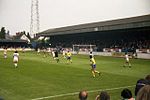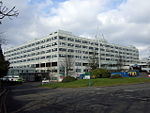Headington Shark
1986 establishments in England1986 sculpturesBuildings and structures in OxfordCulture in OxfordFiberglass sculptures in the United Kingdom ... and 3 more
Outdoor sculptures in EnglandSharks in artTourist attractions in Oxford

The Headington Shark (proper name Untitled 1986) is a rooftop sculpture located at 2 New High Street, Headington, Oxford, England, depicting a large shark embedded head-first in the roof of a house. It was protest art, put up without permission, to be symbolic of bombs crashing into buildings.
Excerpt from the Wikipedia article Headington Shark (License: CC BY-SA 3.0, Authors, Images).Headington Shark
New High Street, Oxford Headington
Geographical coordinates (GPS) Address Phone number Nearby Places Show on map
Geographical coordinates (GPS)
| Latitude | Longitude |
|---|---|
| N 51.75882 ° | E -1.213238 ° |
Address
Joanne
New High Street 4E
OX3 7AJ Oxford, Headington
England, United Kingdom
Open on Google Maps









